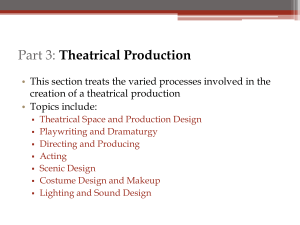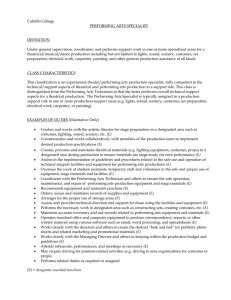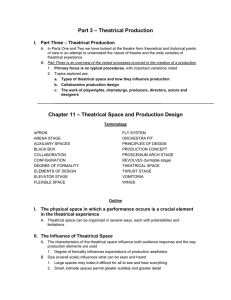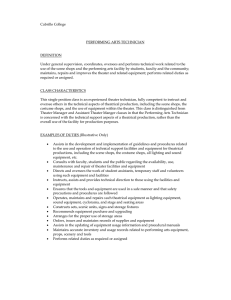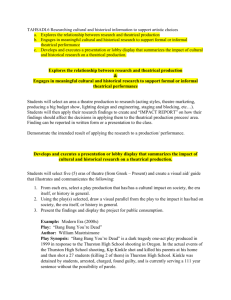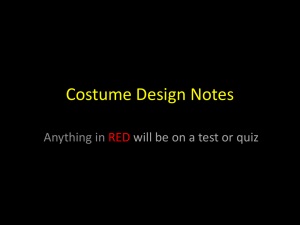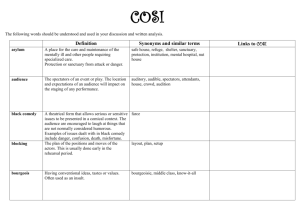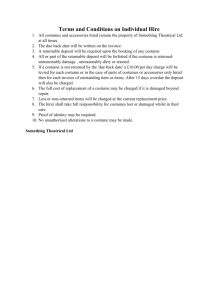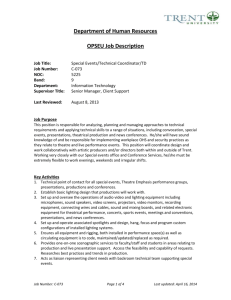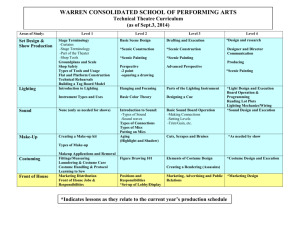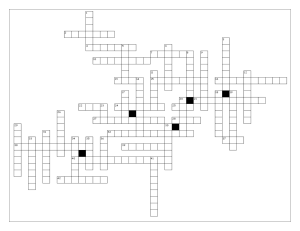Theatrical Production
advertisement
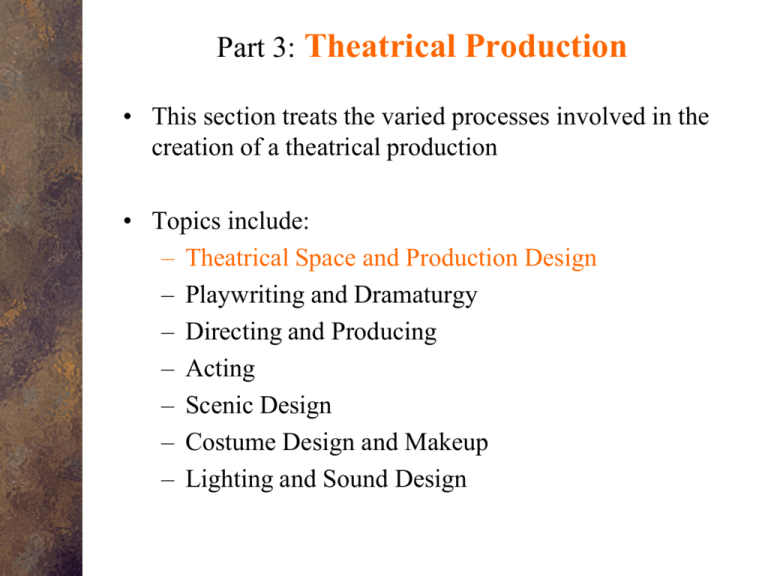
Part 3: Theatrical Production • This section treats the varied processes involved in the creation of a theatrical production • Topics include: – Theatrical Space and Production Design – Playwriting and Dramaturgy – Directing and Producing – Acting – Scenic Design – Costume Design and Makeup – Lighting and Sound Design Chapter 11: Theatrical Space and Production Design The Influence of Theatrical Space • Factors that influence audience response and the use of production elements: – Degree of formality – Size – Arrangement or configuration The Influence of Theatrical Space STAGE Proscenium AUDIENCE Thrust STAGE AUDIENCE The Influence of Theatrical Space AUDIENCE STAGE Arena AUDIENCE AUDIENCE Flexible STAGE AREA AUDIENCE The Proscenium Arch Stage • Raised platform framed by arch • Marks division between stage and auditorium clearly • Sometimes includes an apron = extension of acting platform slightly beyond proscenium arch into auditorium • Seats on one level or raked upwards toward back of auditorium; may include one or more balconies • Stage designed to be seen from front only • Overhead system for movement of scenery = fly system • Offstage space at sides = wings STAGE AUDIENCE The Thrust Stage • Raised platform surrounded on 2 or 3 sides by seating • Brings spectators closer to the action • Discourages realistic spectacle due to sightlines • Most do not have fly systems, although lighting instruments may be hung overhead • Scenic units shifted by hand STAGE AUDIENCE The Arena Stage • No platform: open space at floor level • Seating usually a stepped arrangement on 4 sides of acting area • Fully 3-dimensional playing area • Very restricted scenery due to sightlines • Generally no fly system • • Scene changes made in full view or in semi-darkness, usually by hand Passageways running under seating and opening onto the acting area = vomitoria AUDIENCE STAGE AUDIENCE Flexible Space • No defined rules about the audience/actor relationship • Arrangement changes from production to production or even during the same performance • In modern times, the flexible space has been used since the 1960s • When indoors: often referred to as a black box since it is basically a a bare room with black walls • Indoor or outdoor; small or large • Intermingled arrangement may use multiple focus AUDIENCE STAGE AREA AUDIENCE Auxiliary Spaces • Some spaces function as audience facilities • Other spaces function as work areas for theatrical personnel • Auxiliary spaces for theatrical personnel may include: 1. Scene Shop 7. Control Booths 2. Property Room 8. Rehearsal Rooms 3. Costume Shop 9. Dressing Rooms 4. Costume Storage 10. Greenroom 5. Light Shop 11. Business Offices 6. Lighting Storage Using the Theatrical Space • In most instances, the audience space cannot be manipulated; directors view it as fixed and unchangeable • Some directors use Flexible Space as an integral part of production design • Examples: • Jerzy Grotowski • Peter Stein Collaborative Production Design • The audience typically perceives a production design through hearing and seeing • Aural components include: • • Sound Design • Actor’s Voices Visual components include: • Scenery • Costumes • Lighting • Actor placement and movement Collaborative Production Design • Visual elements of design: • • Line • Shape • Space • Color • Texture • Ornamentation These elements function as building blocks for designers and for the director Collaborative Production Design • Basic principles of design: • • Harmony • Balance • Variety • Proportion • Rhythm • Emphasis These elements help the designers and the director to use the visual elements effectively Collaborative Production Design Costume Designer Scenic Designer Lighting Designer Sound Designer Director common interpretation or goal coordinated aspects of production cohesive experience for audience Collaborative Production Design • Most designers begin with the script, completing a series of readings to accumulate relevant information on: • Action • Characters • Themes • Language • Meaning Collaborative Production Design • • Designers also use other sources to assemble information on topics such as: • The specific look of the period of the play’s action • The manners and customs of a time period or culture • The theatrical conventions of the time period during which the play was written/performed • The quality of light and sound in various locations indicated in the play • The political and social contexts out of which the play came The designers and the director meet to discuss the play and its interpretational focus Collaborative Production Design Costumes Lighting Sound Scenery each element can project messages and evoke responses Lighting Costumes Sound Scenery Theatrical production is an inherently collaborative process. The final product is a group creation.
